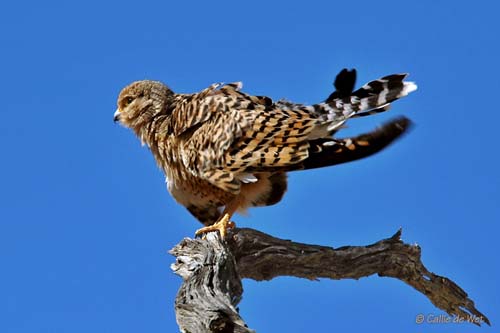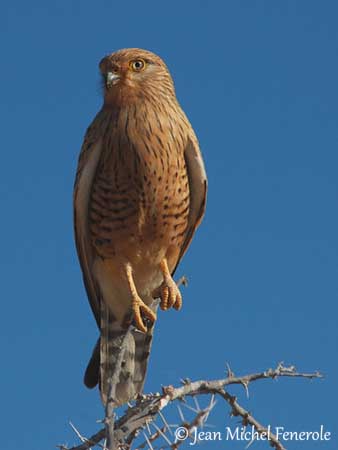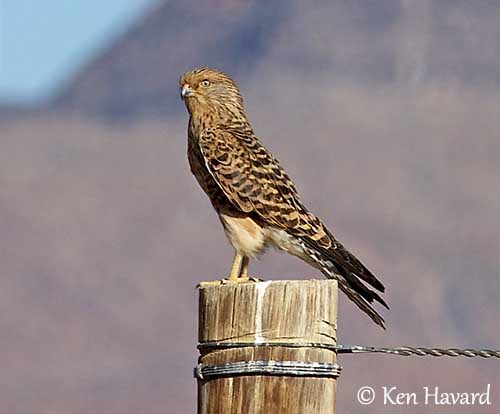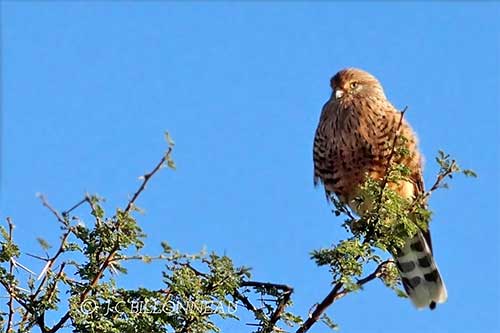
Greater Kestrel
Falco rupicoloides
Falconiforme Order – Falconidae Family
BIOMETRICS:
Length : 34-38 cm
Wingspan : 84 cm
Weight : 178-334 g
LONGEVITY : Up to 6 years
DESCRIPTION:
Greater Kestrel is pale rufous overall. Upperparts (back and wing coverts) are pale rufous barred with broad black bars. Rump is pale grey barred with dark grey bars. Tail is pale grey with dark grey bars, and broad terminal white band. Flight feathers are sooty-brown with narrow paler bars, rufous above and buff below.
Underparts (throat, chest and upper belly) are rufous, finely streaked with black. Flanks show rufous colour with broad black bars. Underwing coverts and vent are plain pale rufous.
Head and neck are pale rufous, finely streaked with black. It lacks the typical black malar stripe. Bill is black with blue-grey base and yellow cere. Eyes are whitish with yellow eye-ring. Long bare legs and strong feet are yellow.
Both sexes are similar, with female slightly larger than male.
Juvenile is generally more rufous. Flanks and breast are more heavily streaked. Rump and tail are rufous instead grey, with dark bars. Eyes are dark brown instead pale cream.
Fr: Crécerelle aux yeux blancs
All : Steppenfalke
Esp : Cernícalo Ojiblanco
Ital : Gheppio maggiore africano
Nd : Grote Torenvalk
Russe : Большая пустельга
Sd : Afrikansk Tornfalk
Photographers:
Jean-Claude Billonneau
Photographe-témoin de la Beauté du Monde
Jean Michel Fenerole
Photos d’Oiseaux du monde
Ken Havard
My Bird Gallery & Flickr gallery 1 & Flickr gallery 2
Callie de Wet
GALLERY
Text Nicole Bouglouan
Sources:
HANDBOOK OF THE BIRDS OF THE WORLD Vol 2 by Josep del Hoyo-Andrew Elliot-Jordi Sargatal - Lynx Edicions - ISBN: 8487334156
BIRDS OF AFRICA SOUTH OF THE SAHARA by Ian Sinclair and Peter Ryan - Princeton University Press Princeton and Oxford - ISBN: 0691118159
BIRDS OF PREY OF AFRICA AND ITS ISLANDS by Alan and Meg Kemp - Struik Publishers - ISBN: 1770073698
Wikipedia (Wikipedia, The Free Encyclopedia)

BEHAVIOUR:
Greater Kestrel is often perched upright on its long legs, on prominent mound, rock, tree or utility pole.
It feeds on small birds and mammals, also insects, mainly caught on the ground. It may hunt by aerial chase, but less often, and rarely on the wing. But it soars or hovers when searching for preys.
Greater Kestrel flies frequently and performs fast flicker-diving as territorial displays while calling.
It is usually found alone or in pairs.
FLIGHT:
Greater Kestrel flies frequently, mainly in light breezes, flapping and gliding from perch to perch, or soaring and hovering when searching for prey. It may fly swiftly when hunting or if disturbed.
REPRODUCTION:
Greater Kestrel nests in trees. It often uses abandoned nests of other birds. But it may sometimes build its own nest with sticks, in low trees or in poles and pylons. It also uses nests located high in Acacia trees, small structures hidden in thorny branches. Nest is lined with fibres, grasses, and sometimes spider webs.
Female lays 3 to 5 eggs. Incubation lasts about 32 days, mainly by female. Male brings food to her and the chicks.

We can find three subspecies:
Falco rupicoloides rupicoloides, from Namibia, Botswana, SW Zambia, and Zimbabwe to South Africa.
Falco rupicoloides arthuri, from Northern Tanzania and Kenya, similar but smaller than previous.
Falco rupicoloides fieldi, from Somalia and northern Kenya, is much paler, almost straw-colour and smaller.
VOICE: SOUNDS BY XENO-CANTO
Greater Kestrel utters shrill, screaming, repeated calls “keeer-keeer-keeer” in territorial displays.
HABITAT:
Greater Kestrel lives in flat open grasslands and semi-arid steppes with some scattered trees. It may be found at altitudes up to 7.000 feet.
RANGE:
Main range of Greater Kestrel is southern Africa, with the other groups in their separate ranges which may sometimes overlap. We find it in Kenya, Tanzania, South Africa and Somalia. Greater Kestrel is sedentary throughout its range, with sometimes some local movements, according to rainfall conditions.

DIET:
Greater Kestrel feeds mainly on insects, but also on small mammals and birds, reptiles and small snakes taken on the ground.
PROTECTION / THREATS / STATUS:
Greater Kestrel is common in southern Africa, but more local in North-eastern Africa.
Clearing of woodlands for agriculture has probably allowed the expansion of the range, but grassland habitat has been lost to agriculture and degradation.
Greater Kestrel is globally categorized as a species of “Least concern” by Birdlife International, and regionally as “Near threatened”.
